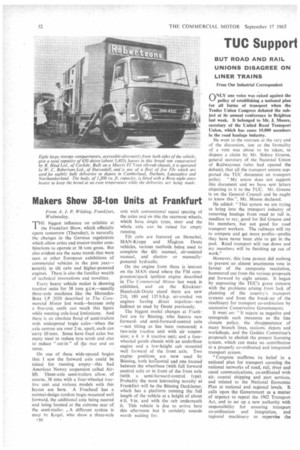Makers Show 38-ton Units at Frankfurt
Page 54

If you've noticed an error in this article please click here to report it so we can fix it.
From A. J. P. Wilding, Frankfurt, Wednesday.
THE biggest influence on exhibits at I the Frankfurt Show, which officially opens tomorrow (Thursday), is naturally the changes in the German regulations which allow attics and tractor-trailer combinations to operate at 38 tons gross. But also evident are the same trends that were seen at other European exhibitions of commercial vehicles in the past year— notably in tilt cabs and higher-powered engines. There is also the familiar wealth of technical innovations and novelties.
Every heavy vehicle maker is showing tractive units for 38 tons g.t.w.—usually three-axle machines like the MercedesBenz LP 2020 described in The Commercial Motor last week—because only a five-axle outfit can reach this figure while meeting axle-load limitations. And there is an absolute flood of semi-trailers with widespread bogie axles—when the axle centres are over 2 m. apart, each can "carry 10 tons. Some have fixed axles but many steer to reduce tyre scrub and also to reduce "cut-in" of the rear end on turns.
On one of these wide-spaced bogies that I saw the forward axle could be raised for running empty—this had American Neway suspension called Airlift. Three-axle semi-trailers allow, of course, 38 tons with a four-wheeled tractive unit and variouS models with this layout are here. A Fruehauf has a normal-design tandem bogie mounted well forward, the additional axle being steered and being located at the extreme rear of the semi-trailer. . A different system is used by Koeel, who show a three-axle .16 unit with conventional equal spacing of the axles and on this the rearmost wheels, which have single tyres, steer and the whole axle can be raised for empty running.
Tilt cabs are featured on Henschel, MAN-Krupp and gagirus Deutz vehicles, various methods being used to complete the tilt: manual, air-assisted manual, and electroor manuallypowered hydraulic.
On the engine front there is interest on the MAN stand where the FM compression/speck ignition engine described' in The Commercial Motor last week is exhibited, and on the KlocknerHumboldt-Deutz stand there are new 210, 180 and 135 b.h.p. air-cooled vee engines having direct injection—not indirect as used by Deutz previously.
The biggest model changes at Frankfurt are by Biissing, who feature new forwardand semi-forward-control cabs —not tilting as has been rumoured; a two-axle tractive unit with air suspension; a 6 X 6 tractive unit; and a fourwheeled goods chassis with an underfloor engine and a low-height cab mounted well forward of the front axle. Two engine positions. are now used by Bussing, both horizontal and one located between the wheelbase (with full forward control cab) or in front of the front axle (with a semi-forward-control type). Probably the most interesting novelty at Frankfurt will be the Bussing Decklaster, which has a platform running the full length of the vehicle at a height of about 4 ft. 9 in. and with the cab underneath it. This vehicle is due to arrive here this afternoon but it certainly sounds worth waiting for.




















































































































































































